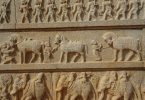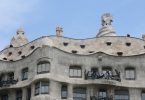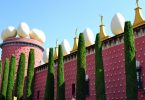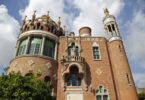There are a variety of gorgeous pieces of architecture in Barcelona but one of the most stunning of all is, undoubtedly, Palau de la Música Catalana. The building was originally designed in the Catalan modernist style by one of the region’s most famous architects, Lluís Domènech I Montaner, with construction taking three years, starting on 1905 and ending on 1908. The building was constructed on behalf of the Orfeó Català, at that time a leading force in the Catalan cultural movement that came to be known as the Renaixença (Catalan Rebirth).
Related article: Casa Amatller – a modernist marvel of Barcelona
Table of Contents
The Palau, throughout the years



Photo by atl10trader via Visualhunt
When the Palau was finally declared open in 1909 Barcelona’s City Council awarded Lluís Domènech i Montaner the prize for the best building constructed in the city for that year. Between 1982 and 1989, the Palau de la Música Catalana was extensively renovated and remodeled, with a large extension to the original building being added on. In 1997, the Palau de la Música Catalana was declared a UNESCO World Heritage Site.
The Palau, today
Today, more than half a million people visit the Palau each year not only to attend musical performances but also to enjoy the building’s tremendous architecture. The building is located in the neighborhood of Sant Pere – Santa Catarina i la Ribera, which belongs to the district of Ciutat Vella. Standing out against the background of fairly typical and unexciting architecture of that era, a first view of the Palau de la Música Catalana can be a breathtaking experience for first-time visitors.
Decorative elements
The Palau de la Música Catalana is a magnificent example of the Catalan modernist style, with a design that presents an abundance of curved lines and dynamic shapes, as well as a sumptuous decoration that uses a number of nature-related motifs. The Palau may be one of the most truly Catalan constructions there are in the city due to the fact that there was an express request made to the architect that he applied materials and techniques that represented the Catalan character. To make sure that he fulfilled this request, Montaner hired a number of local craftsmen and artisans who crafted exquisite decorative, structural, ornamental and sculptural elements. The façade itself is one of the most stunning parts of the building, combining elements of both Spanish and Arabic architecture, being richly decorated, and mixing exposed brick with mosaics, iron, stained glass and glazed tiles. Inside, the concert hall is the must-see area of the building, decorated with massive sculptures, a gigantic pipe organ, and the most amazing skylight which is made completely out of stained glass, allowing the room to be illuminated only by sunlight during the day.
Related article: Casa Planells
Useful information



Photo by thierry llansades via Visualhunt
Palau de la Música Catalana is located at Carrer Palau de la Música, 4-6. It can easily be reached by using the yellow line of the subway, stopping at Jaume I and taking the exit towards Jonqueres. Visitors can also take buses V15, V17, and 45 to get to the Palau.
Visitors can enter the venue and see the main hallway without paying, stop by the gift shop or have a nice cup of coffee at the venue’s cafe. Tickets to visit the rest of the building, which include a guided tour, cost 18€ per person for adults, 10€ for those who live in Catalonia, and 11€ for students, seniors, and unemployed people. Children under 10 years old can go in for free. The tours take place in Spanish, Catalan, French, Italian and English, and they happen every 30 minutes from 10 am to 3:30 pm.
Other works by Lluís Domènech I Montaner
If after your visit to Palau de la Música Catalana you feel that you want to explore more works by the talented Catalan architect Lluís Domènech I Montaner, then you can pay a visit to Park de la Ciutadella, where you will find the Castillo de los Tres Dragones (Three Dragons Castle), or you can go to the Guinardó neighborhood and discover the modernist wonderland that is the Recinte Modernista de Sant Pau.
Looking for an apartment in the city? ShBarcelona is the answer.
* Main photo by kkmarais via Visualhunt






















Leave a Comment